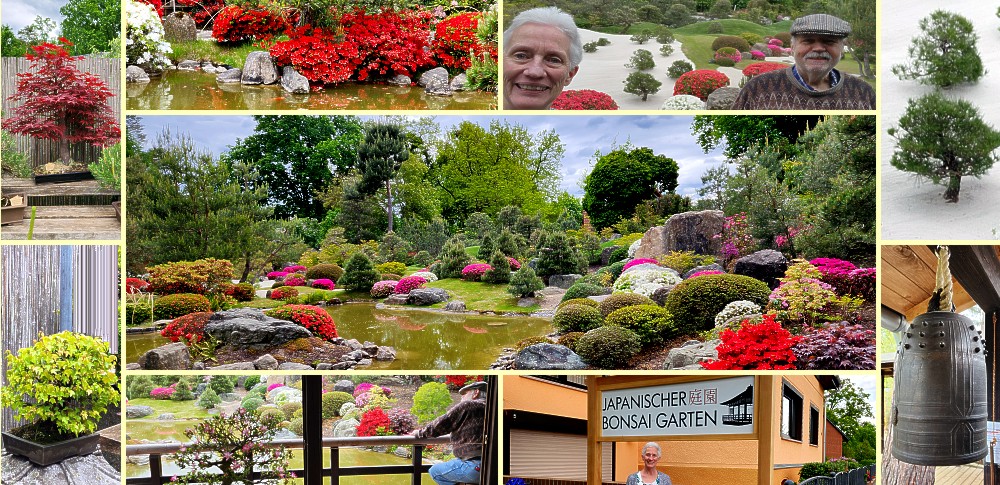Kansas Snapshots by Gloria Freeland - June 13, 2025
Bonsai
On our recent trip to Germany, husband Art and I didn't have any particular plans other than to make sure we saw our German "kids"
Nadja and Tim and their families and friend Matthias and his family.
We've been to the Berlin area often enough that we've seen the usual tourist sites - the Brandenburg Gate, the Reichstag (parliament)
building, remnants of the Berlin Wall, the cathedral, the TV tower, the Charlottenburg and Sanssouci palaces, and many more. Our plan
was to not be typical tourists, but instead to just relax - shop for food when we needed it, eat out when we didn't feel like
cooking, and perhaps see new things when the mood struck us.
This "plan" worked better than expected. Before the trip, we had some sort of "bug" that left us feeling fine, but tiring easily.
Sightseeing and feeling as if you need a nap are not good companions. But "little sights" - such as seeing Albert Einstein's summer
home - were a good match for our limited energy levels. Sticking with that "little" theme, we discovered there was a Japanese bonsai
garden nearby. It was another perfect choice. While most formal gardens are intended for wandering, a bonsai garden is designed for a
visitor to pick a vantage point and then sit and "experience" what is seen, much as a person would a picture.
A bonsai garden in Germany? When I told friend Deb about our visit, she wondered whether we had made a side trip to Japan.
But no, it was in Ferch near Berlin, just a few miles from Wilhelmshorst, where we were staying.
Art wasn't all that excited about going, but it was one of the few things I kept mentioning, so he relented.
It was a cloudy day, so the colors didn't "pop" like they normally would. Still, the garden was a feast for the eyes with its
beautiful azaleas, rhododendrons, cherry trees, koi pond, and tiny pine trees, Japanese maples, and other plants ranging from
decades-old to hundreds-of-years old. The pavilion and the tea house, stopping points for visitors to enjoy the serenity of the
garden, were charming in their simplicity.
I also enjoyed learning about the art of bonsai. A plaque near the entrance listed 10 misconceptions about it, and I have a hunch,
like me, many people believe at least some of them.
1. The art of bonsai originated in Japan. - The word "bonsai" - which literally means "planted in a container" - comes from
Japan, where they have been cultivated since the 7th century. However, the art was adopted from China, where the technique has existed
since the 4th century.
2. Bonsai are specially-bred plants that stay small on their own. - Any type of plant that forms a trunk and branches can be
trained into a bonsai. They are kept small by pruning.
3. With a bonsai, you have to cut the roots to keep the plant small. - The roots are cut every two to three years to give the
plant space to grow. But it stays small by cutting the trunk.
4. Anyone who cares for a bonsai must cut the stems every day. - It takes weeks or months until the stems are long enough to
be cut. Depending on the plant species, pruning is required once or twice a year.
5. Bonsai can be kept in the living room. - Only tropical plants can be placed by a window in warm temperatures. All other
plants, however, need a cooler location in winter and a place outdoors in summer.
6. With bonsai, the trunk or roots must be girdled with wire so that the plant stops growing. - If the supply of nutrients to
the crown is prevented by a wire loop, it will wither, become susceptible to pests, and may die.
7. Bonsai are only sprayed with water. - Spraying imitates the morning dew, but it is not a substitute for watering.
8. Bonsai plants are immersed instead of watered. - If the root ball becomes completely dry, the plant should be immersed. But
if done repeatedly, too many nutrients and soil will be washed out, so it is better to water until it begins to seep out of
the drainage holes in the pot.
9. Bonsai plants stay in the same pot for their entire lives. - The soil is changed every few years, and sometimes a larger pot
is needed.
10. Bonsai plants are a mutilation of nature. - Natural bonsai in rock crevices can be found in the mountains. These plants
have remained small because they have repeatedly dried out.
The Japanese Bonsai Garden in Ferch is a multi-generational family-run business. Owner Tilo Gragert has been interested in bonsai
since 1976, when he read a book on the subject that his mother had. He was so fascinated with the art that he studied it in Japan
in 1994. He began creating his garden in 1996.
Our daughter and son-in-law visited Japan last fall. But I have a hunch one of my few contacts with Japanese culture just took
place in Germany.
